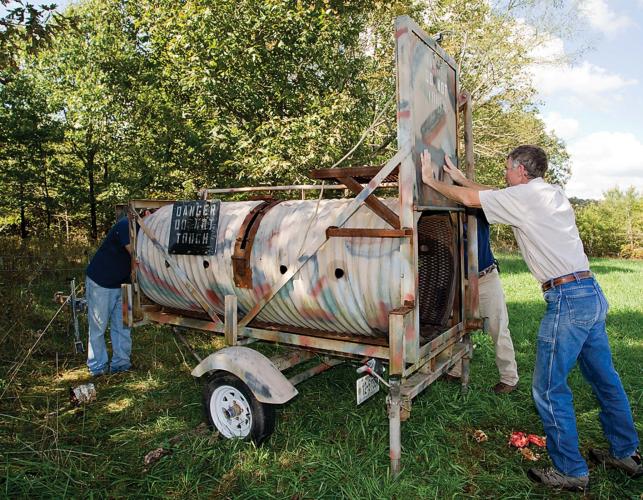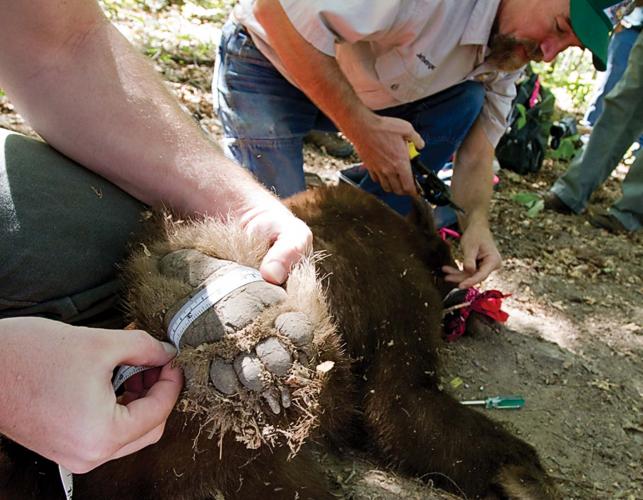Behind the metal grate door of the large barrel trap was 400 pounds of proof that black bears are doing well in Missouri. Returning the inquiring stares of Missouri Department of Conservation biologists with curious looks of its own was a large animal whose appearance indicated the surrounding Webster County countryside was satisfying its creature comforts quite nicely. Its blackish brown fur was smooth and thick. Its frame meaty and robust.
It seems strange to call a creature this large “elusive,” yet that is exactly what black bears (Ursus americanus) have been to Missouri wildlife experts for a number of years. A multiyear study, currently underway, should dispel much of the mystery about this creature and replace hunches with hard facts. This information will be used to better manage one of the state’s largest wild mammal.
Seeking the Bear Facts
For several decades, Missouri’s bears have been something of an enigma for the state biologists trying to study them. Numerous sightings have provided definitive evidence that black bears live in the Show-Me State, but when it came to specific details (how many are here, are they year round residents, etc.), things weren’t as clear.
“I don’t know how many bears we have,” said Jeff Beringer, a resource scientist with the Department of Conservation and the project leader of the bear study. “I know we have reproduction and healthy animals, but there is no way to come up with an intelligent guess—and a guess is all it would be. We need to define bear range in the state and know how many females we have, and then we can start making estimates.”
These are some of the goals of the current research project, which is a joint effort of the Missouri Department of Conservation, the University of Missouri-Columbia and Mississippi State University. It is being funded through the U.S. Fish and Wildlife Service’s Wildlife Restoration Program with help from Safari Club International Foundation.
Catch and Release
Trapping bears involves either enticing them into large, cylindrical barrel traps with bait, or catching them in baited snares.
Once trapped, the bears are tranquilized and biologists collect weights, measurements and extract a pre-molar tooth. This tooth extraction will provide valuable age and genetic information for biologists without negatively impacting the bear’s ability to chew or digest food. At the conclusion of the data collection process, the bear is transported a short distance away from the trap site where it will revive in a short period of time.
Department of Conservation biologists hope the wide range of data they’re collecting will give them a clearer picture of the bears that are showing up with increasing frequency in southern Missouri.
“We will learn the extent of occupied bear habitat and learn the habitat bears use by season,” Beringer said. “This will help us to protect and manage for bears. We will learn travel corridors, where and when bears cross highways and other roads as well as when and where bears den.”
Every bear trapped has the potential to reveal information that is useful. Studying males will help biologists understand when breeding occurs, when the males disperse and how far they travel. Studying cubs and yearlings will reveal important clues about survival rates, gender ratios and population growth. But it’s the females that hold some of the most valuable information for biologists.
“Females drive population growth,” Beringer said. “Knowing reproduction and survival rates for females will enable us to better predict population growth rates for bears.”
Bear Biology
Although the 400-pound male caught in Webster County is on the large end of the scale for a Missouri black bear, larger bears have been recorded in other states. Black bears can hear a wider range of frequencies than humans, but their greatest sensory attribute is their sense of smell. A black bear’s nasal mucosa area (the internal area of the nose which contains special sensory cells for collecting scents) is approximately 100 times the size of a human. Top these traits off with an ability to run up to 30 mph and it’s easier to understand why Missouri’s bears have been difficult to observe and study.
One trait long associated with bears—hibernating—may be something of a mischaracterization: It all comes down to how one defines hibernation. In colder parts of their North American range, black bears retire to winter dens in late fall or early winter (depending on food availability) and go into a deep period of lethargy and sleep. Although bodily functions are greatly slowed, they are not suppressed to the same degree as with deep hibernators such as groundhogs or ground squirrels. Also, bears alternate periods of light and deep sleep throughout the winter and may even leave their dens for short periods when its warm, something deep hibernating mammals don’t do. Male bears, in particular, have been known to be active in winter.
Bear Research Timeline
Fall 2010
13 bears were trapped and radio collared in southwest and south-central Missouri. These bears will be monitored over winter to learn more about denning habits and the time frame of winter denning in Missouri.
Spring 2011
Hair snares at select sites throughout southwest and south-central Missouri will collect data that will help biologists get better estimates of overall population and male/female ratios.
Fall 2011
13 bears will be trapped and radio-collared in southeast Missouri and those bears’ denning habits will be monitored over the winter.
Spring 2012
The field portion of this project concludes with setting of hair snares in southeast Missouri.
*Much of this trapping will take place on private land, which provides further evidence that Missourians care about conserving forests, fish and wildlife.
History and Heritage
Seeing a bear at any time of the year in present day Missouri is considered a wildlife viewing novelty because bears were once thought to be nonexistent in the state. However, this wasn’t always the case.
When the first settlers came to Missouri, the black bear ranged across much of the state. Proof of this exists in the form of paleontological evidence predating settlement that has been found in some caves and also in countless references made by early settlers.
As Missouri became settled, the state’s black bear population dwindled. Bears were shot for their meat, for the alarm they caused (whether they were harming anything or not) and for the lucrative market for bear grease that existed in the United States in the early 1800s. By the close of the 1800s, unregulated hunting and habitat destruction had diminished Missouri’s bear population to remote parts of the state. By the mid-1900s, it was thought that the only place bears could be seen in Missouri was on the state seal.
But the black bears’ story in Missouri wasn’t finished. From 1958 to the late 1960s, the Arkansas Game and Fish Commission trapped 254 black bears in Minnesota and Manitoba, Canada, and relocated them to Arkansas to join the small population still thought to be roaming the state. This population took hold and soon wandering bears from Arkansas began appearing in Missouri. It’s thought that most of the bears seen in Missouri today are the result of Arkansas’ reintroduction program.
Most, but perhaps not all of them. Before the current bear study was formally underway, some intriguing data had been discovered in southwest Missouri. Genetic information extracted from hair samples collected on a Webster County farm showed DNA that did not match that of Arkansas bears. This indicated these bears may have been the progeny of a “true” Missouri bear whose descendants had resided in the remote parts of the state and never completely disappeared.
Regardless of what their heritage is, there is no doubt black bears are part of Missouri’s outdoors today. Since 1987, more than 800 bear sightings have been recorded in 91 counties.
Nuisance Bears
Along with the increase in bear sightings have come an increase in the reports of bear problems. Black bears are generally docile creatures. However, they’re inquisitive and intelligent, and that’s what can get them into trouble.
Like any wild animal, black bears are constantly searching for their next meal. When they are successful at finding food, they remember where it came from. Most problems people have with bears involve the animals raiding campgrounds, garbage bins, bird feeders, orchards and beehives. The trouble can be compounded when bears are purposely fed by people who think they’re helping them survive or are trying to lure them into range for a good photo.
If a bear visits an area and is rewarded with food, it will very likely return. Though they are generally not aggressive, they are powerful and can cause damage to buildings, trailers, vehicles and just about anything else that they view as an obstruction in their search for food.
“We have had an increase in bear/human conflicts in recent years,” Beringer said. “Most conflicts can be prevented if folks do not give bears access to food or garbage.”
As a means of further reducing the chance of bear/human conflicts, information collected in the current study may result in the institution of a limited black bear hunting season. This would give hunters a chance to spice their table fare with bear meat and is an example of how good conservation makes Missouri a great place to hunt and fish.
“Hunting is used to maintain bear populations at levels that are compatible with humans and to reduce nuisance conflicts when necessary,” Beringer said. “Most road-killed bears and problem bears are young males. Hunting can be geared to remove a few of the males so that a population can continue to grow, but conflicts with humans are minimized.”
The current bear research project provides an opportunity to improve our understanding of the biology and behavior of a unique species, to support Missourians’ desire to conserve a wide range of wildlife species, and also to reduce potential nuisance issues.
“While there are many good reasons to learn more about a growing wildlife population,” said Department of Conservation Wildlife Division Chief DeeCee Darrow, “one important reason is that when we know more about bear habits and bear movements in Missouri, we should be able to provide better information to citizens and to work more effectively with landowners who have bear problems. It’s win-win.”












Also In This Issue


And More...
This Issue's Staff
Managing Editor - Nichole LeClair Terrill
Art Director - Cliff White
Staff Writer - Bonnie Chasteen
Staff Writer - Jim Low
Photographer - Noppadol Paothong
Photographer - David Stonner
Designer - Stephanie Thurber
Artist - Dave Besenger
Artist - Mark Raithel
Circulation - Laura Scheuler






















